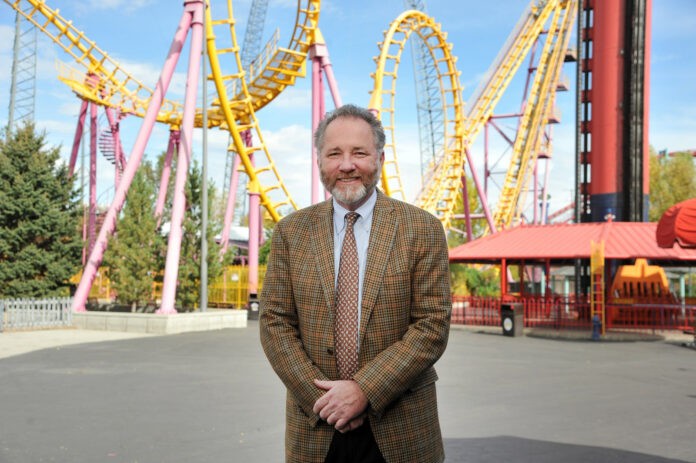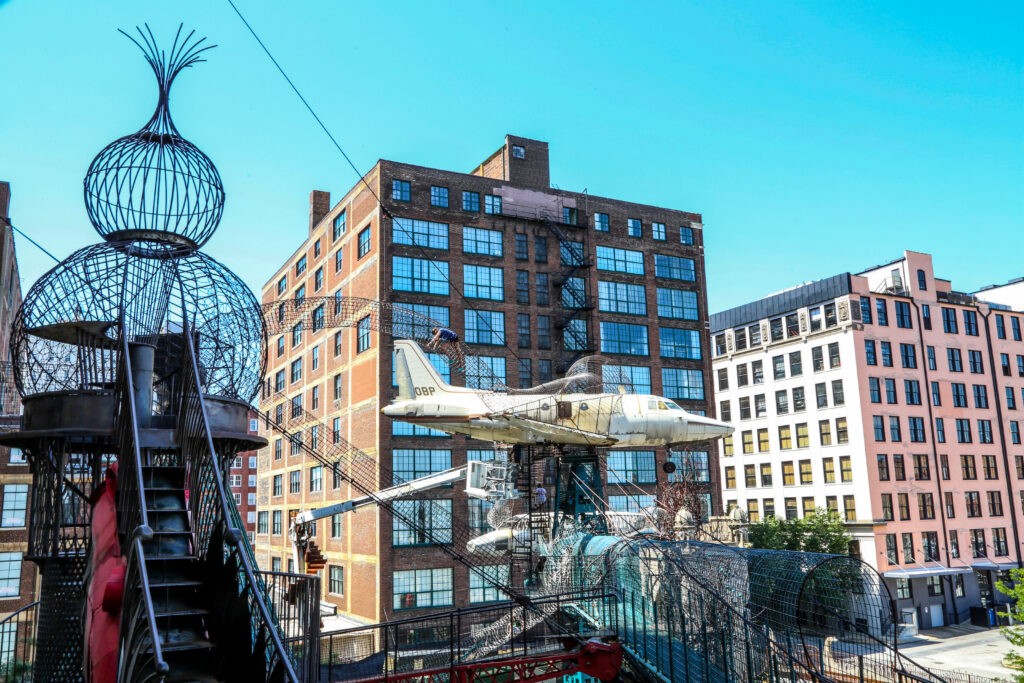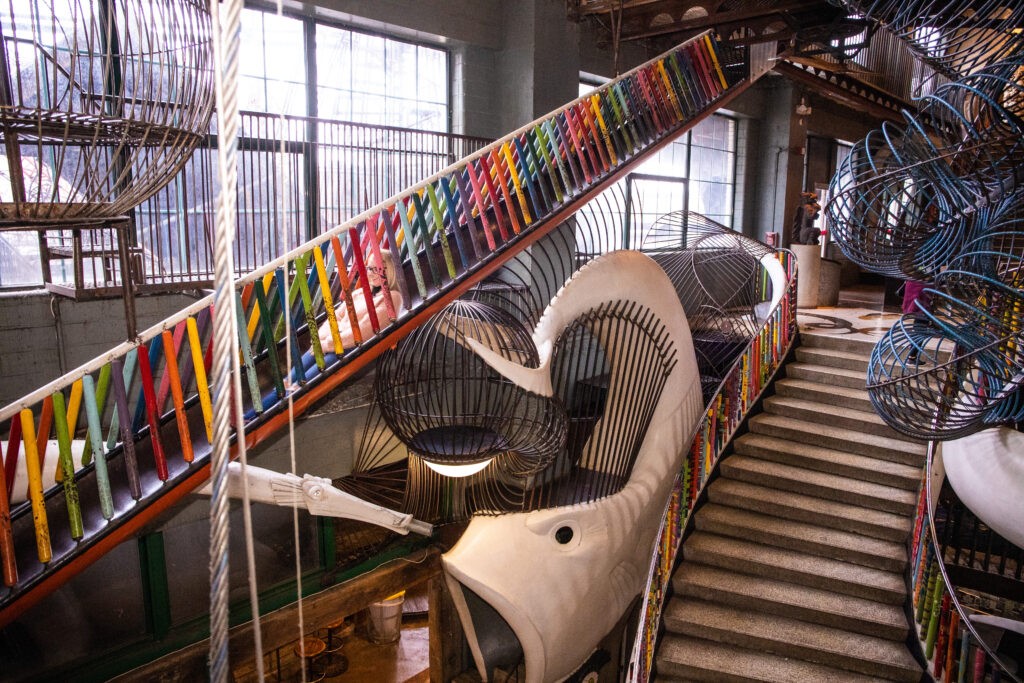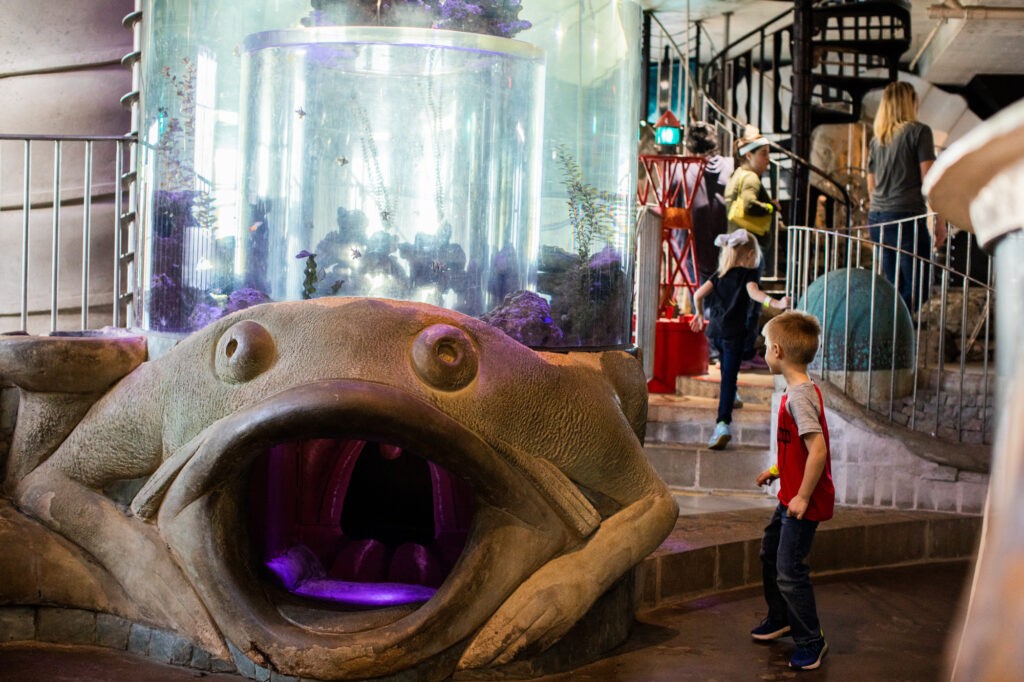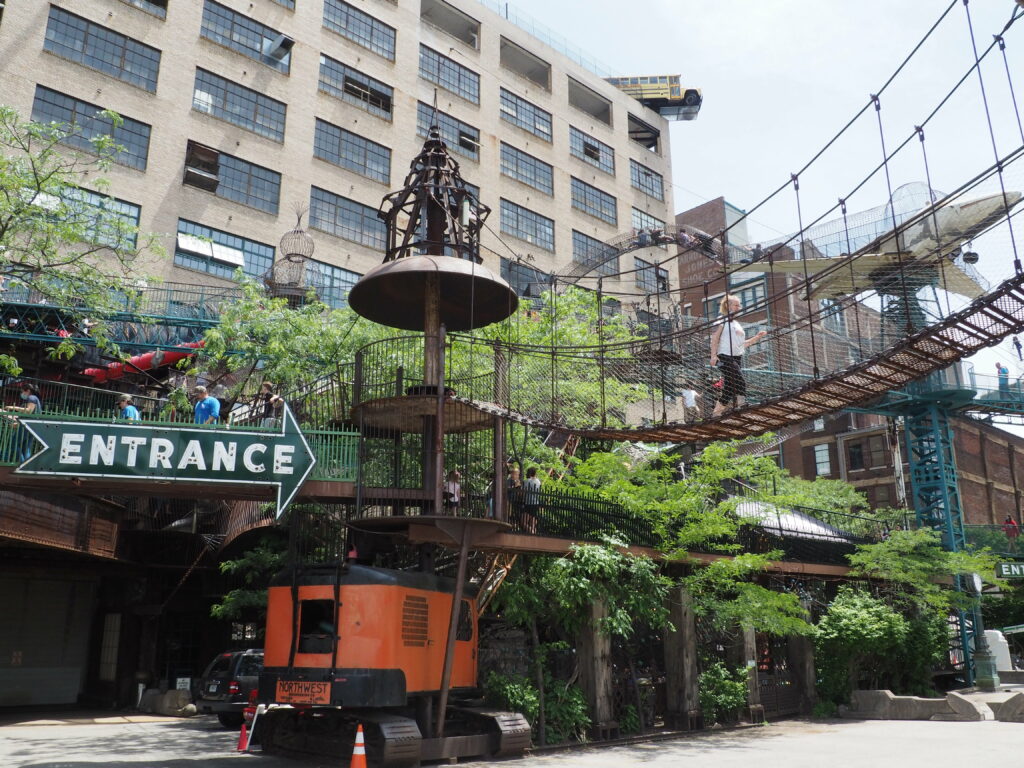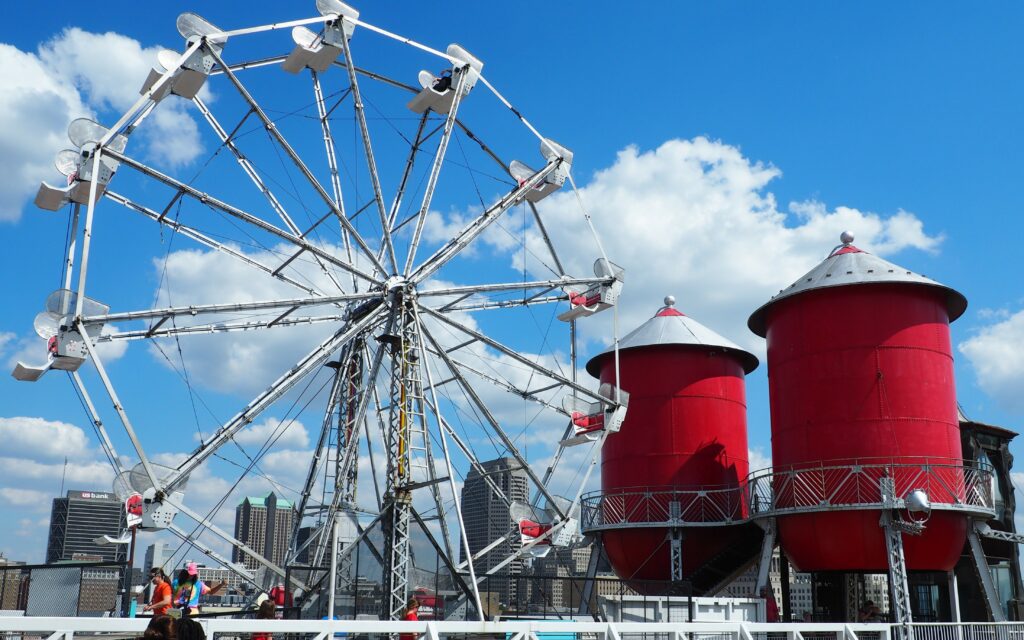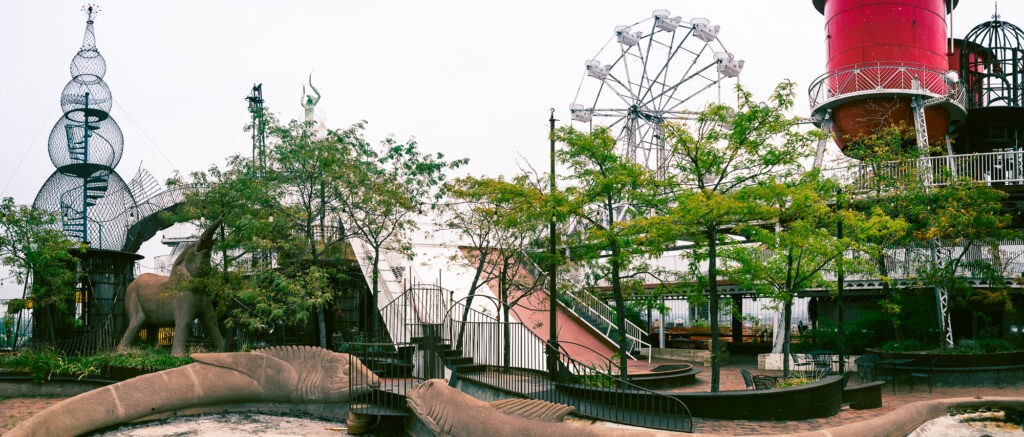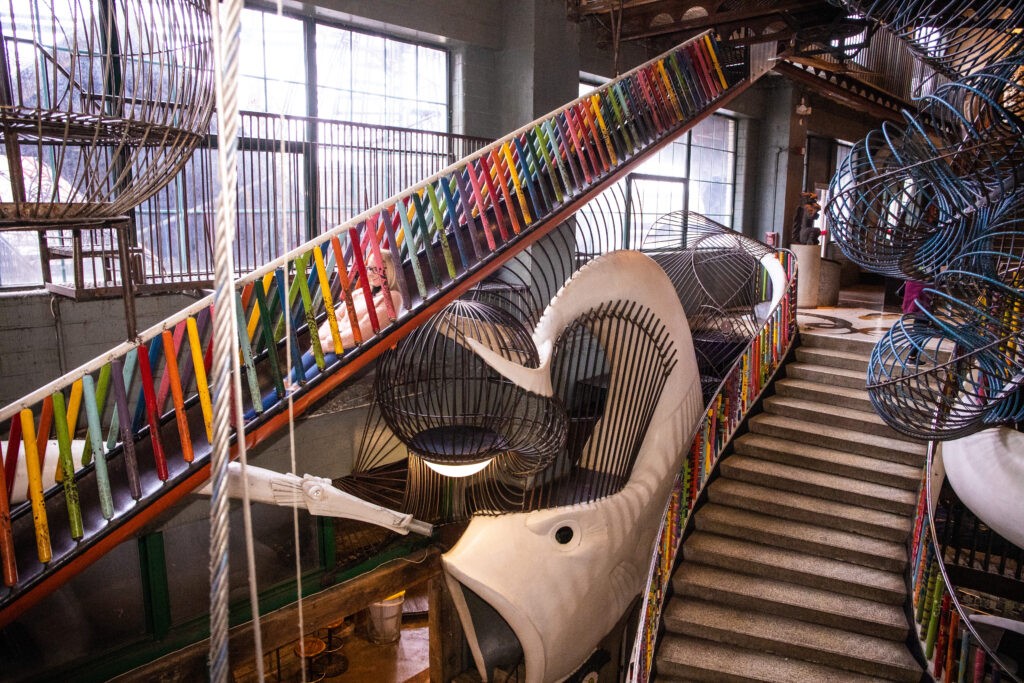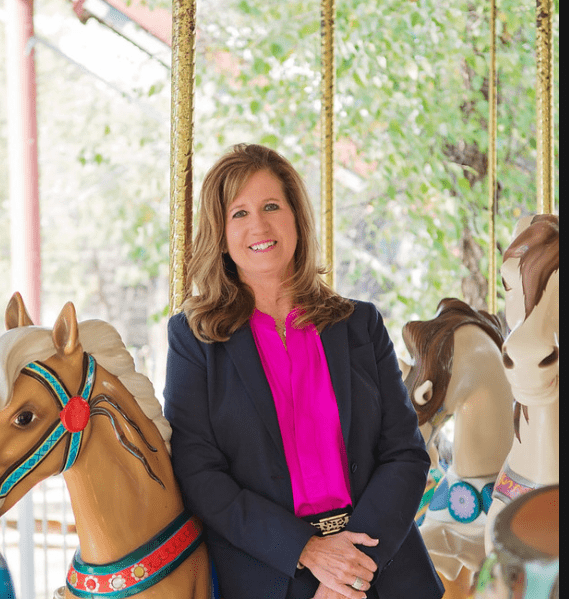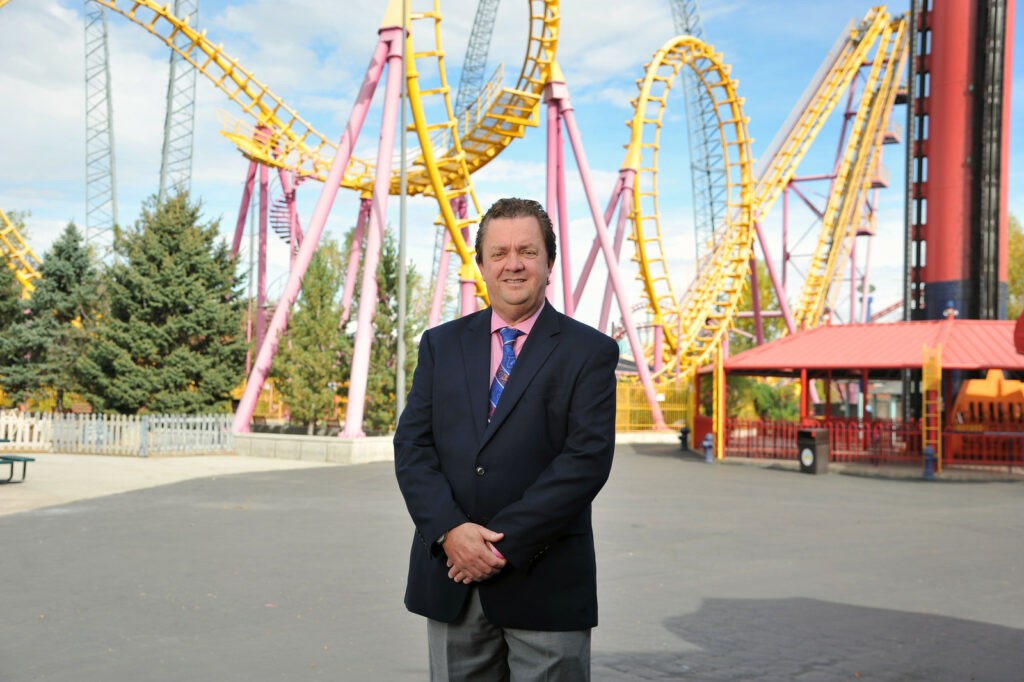Interview by Judith Rubin
In January 2019, Premier Parks, LLC acquired City Museum. This unique and beloved venue in St. Louis, Missouri – with a reported 800,000 visits in 2017 – was founded in a century-old, downtown warehouse in 1997 by Bob and Gail Cassilly. Bob Cassilly was a well-known and influential local artist who left his creative signature on many parts of the city before his untimely death in 2011.
City Museum is an urban adventure experience and something of an archaeological expedition as well as a shining example of creative upcycling. Inside and out, artists have repurposed architectural artifacts and other materials into imaginatively adorned tunnels, slides, climbers, bridges, and castles. There are secret passages and grand galleries, playgrounds and ball pits, a circus and a train, a rooftop school bus and an observation wheel. City Museum is a popular nighttime venue with the city’s younger set, and a place for artists, circus performance, and special events including ballroom dancing and weddings.
InPark editor Judith Rubin, who has made her home in St. Louis City since 2008, spoke to Premier Parks Chairman, President & CEO Kieran Burke about the company’s vision for this iconic urban destination, and its plans in general. Burke, whose career includes 16 years as Six Flags, Inc. Chairman and CEO, founded Premier Parks in 2009.
City Museum is iconic in the St. Louis area, but not that well known elsewhere. How did it come to the attention of Premier Parks?
I’m very fond of St. Louis. I got to know the area because of Six Flags St. Louis. In the late 1990s I worked with Gary Story, then COO of Six Flags. He was a St. Louis native and took me to all the great neighborhood places and restaurants. In addition, my kids were all college tennis competitors and the warmups to the national championships were in St. Louis’s Forest Park. Also, there’s a substantial Irish-American community in St. Louis, and I’m second-generation Irish. My dad was a homicide detective in the Bronx where I was born.
Truly, I’m psyched to be back doing business in St. Louis. I did not, however, learn about City Museum until 2009 when I was studying possible entertainment investments. Becoming aware of Meow Wolf during this period led me to learn about City Museum – there is an interface between City Museum and the Meow Wolf artists collective.
Some time later, Dave Jump, the owner of City Museum who was running the property after founder Bob Cassilly’s death, was looking to put it into the hands of an organization that would preserve its legacy and mission, but also develop and grow it, hopefully taking things to another level. Cassilly, who I never had the pleasure to meet, had conceived of City Museum as a canvas that would never be complete, and that’s how we look at it.
We put in a lot of diligence, research and site visits and frankly, very quickly became extremely enamored. My entire organization fell in love with City Museum and I fell back in love with the city of St. Louis as I became more familiar with it and with what’s going on in downtown, such as the ballpark, the redevelopment of Union Station and the improvements at the Arch grounds. I spent a lot of time reacquainting myself, going to all the museums and amazing attractions. People outside the St. Louis metro don’t necessarily appreciate the quality of the cultural institutions here – many of them free and supported by the community.
Being shut down due to the pandemic caused us to basically lose 2020 operationally, but didn’t interrupt our planning process, and we’re all excited to be back. We have seen a strong rebound in attendance that we expect to continue. We are starting to see tourists coming back. We are optimistic that as we get into 2022, we will be in a more “normal” situation. Our corporate and local teams have done an excellent job identifying a number of ways – and establishing appropriate protocols – to protect employees and the public.
How will you continue the legacy and vision of City Museum founder Bob Cassilly while making improvements?
We see our role as a supportive role, operating with strong local teams. One of the things inherited at City Museum was Cassilly’s crew of artists that create the amazing exhibits. Most remained and have their own studios within the facility. We are very committed to maintaining that crew; the director there is sensational, nurturing artistic development. I feel less like an owner than a curator or someone responsible for more than just a business. We bring our resources and management abilities where we can help with the business side, in everything from maybe making the entrance bigger, to improving the overall campus, lighting, people flow, better food and beverage and retail, to support the artists in the next stage of development.
I think that venues like City Museum represent a great opportunity to reconnect with our local markets as well as tourists. Our research found that area residents have a very high regard for City Museum, though many haven’t visited in a few years. When tourists come to St. Louis, City Museum is on their list of places to visit. Those are things we will continue to maintain and develop. We are working with the museum team to develop programming and special events. We are very focused on broadening City Museum’s appeal while keeping the core of what makes it City Museum – a magical place, unlike anything in the world. With the help of the St. Louis-based design firm PGAV we are creating a master plan to give us a road map for the next five to seven years, and in 2022 we will be implementing some of the first steps toward that enhancement. Among other things, we hope to introduce a tour program.
There is a special magic with City Museum. It is such a complex organism, hard to define. We came to the table with great respect and reverence for what we were acquiring. My mantra to our group was, “We can’t break this, we have to be very thoughtful.” We have needed these last two years to start to dig in, understand, and formulate ways to expand and improve without losing the magic.
How is Premier Parks moving forward with this unique asset to the city of St. Louis as part of the fabric of downtown?
We’re extremely excited not just about City Museum, but its potential to be part of a renaissance in the city. We believe in that. I have operated something like 75 facilities in eight countries, and I have seen that what sometimes happens is that negatives can get inflated – such as certain issues in downtown. But as I spend time and I visit frequently, it’s very clear to me that the seeds are there for improvement and growth. We feel like we can participate in that.
Think of that corridor: the connection between the Arch, the stadium network (with a new MLS venue on the way), Union Station, improvements to the convention center, etc. These are the building blocks of an entertainment tourism zone that can go a long way to accelerating the regeneration of downtown and catalyze a lot more local business development. We’d be happy to participate in that and it could be quite exciting.
There are lots of ways that the St. Louis downtown corridor can be connected to Forest Park with its wealth of cultural institutions. And St. Louis already has many assets to work with, more than many other cities in terms of buildings, cultural institutions, food and beverage, etc. There is so much to build on, and the people of St. Louis are proud of their city. That’s one of the reasons City Museum has done so well – the people embrace and support their cultural institutions and sports teams. I think St. Louis has a very bright future.
How does the ownership of City Museum fit your portfolio and experience?
We currently operate a large facility 10 miles from downtown Nashville that offers a similar model over the 10-12 years we have owned it – an area of the city redeveloped and tied into what’s become a remarkable, vibrant area for residents and tourists. I think St. Louis can go in that direction with a combination of public-private partnerships.
I remember the first park we operated in Oklahoma City. When we acquired the park around 1987, the entire downtown was a bit of a ghost town due to economic problems. A municipal project that devoted a percentage of revenue to downtown redevelopment helped transform old stockyards and created a canal, connecting the area to other parts of town and helping make it the vibrant area it is now. There are similar, great examples around the country. Premier Parks has other properties that are iconic within their regions, such as Pacific Park on Santa Monica Pier.
Historically our team has operated all sorts of hospitality and entertainment properties, all sizes in many countries and markets, downtowns, resort areas, suburban, waterparks, theme parks, pier operations. Within our group is an extraordinary amount of experience covering just about any aspect of the leisure and entertainment business. When we make a new purchase, it usually takes a year or so of transition and assimilation, working with local teams and forming a strategic plan.
Currently Premier Parks operates 13 facilities, with lots of opportunity for growth. We are always open to new involvements – whether acquisition or management, new development or existing, across a broad spectrum. We are flexible on how we become involved. We have recently built up the management team, to include several of my former Six Flags colleagues – you might say the band is back together. That includes Traci Blanks (Chief Marketing Officer), Hue Eichelberger (Chief Operating Officer), Les Hudson (Executive Vice President Design and Planning) and Tom Iven (Executive Vice President of Business Development).
Could something like City Museum be developed in another location?
You couldn’t duplicate it per se, it is such a unique, organic place. Having said that, I think that what allows City Museum to be itself is artistic commitment with economic support. That dynamic allowed a group of special artists, led by one visionary artist (Cassilly) to create this organic museum that grew into what it is today.
What I do think would be possible in other cities is to create that environment where you start with the building and a team of artists in that local community, with the support to enable things to grow and happen. I don’t think the plan would be “in 18 months we’ll build something just like it.” There would be elements of City Museum that would show up in the new experience, but it would be organic growth, it would start and grow and flourish. I do think that’s a possibility and frankly it is something we are looking at. Certain cities around the US have extraordinary artistic communities, and I could see a scenario where the right environment and the right dynamics would come together. It would be very exciting and a great testament to the legacy of Bob Cassilly and the existing City Museum crew. But our first priority is a laser-like focus on City Museum in St. Louis.
How do you see the trend of artists collectives building guest experiences within the larger attractions universe?
These are what I call artistic musical immersive experiences and I think the trend represents a sea change, particularly among younger people – but families and older adults, too – that speaks to placing a high value on experiences over things. It’s also being reflected in more traditional settings: for example, visitor traffic to US Park Service locations has set records, camping and RV experiences are transforming radically, bowling and golf have also been transformed. I think it is particularly interesting to see these experiences in urban settings, as standalone venues. It is quite an exciting development and a positive one for anyone in our industry. Certainly, consumers are embracing it.
We are at a transformative moment with tech creating so many tools for creatives to use. It’s happening so quickly. It’s a very exciting time to be involved in it and something I hope to see leveraged in the St. Louis downtown community. We view it as a way to make the entire offering of the city fuller and bigger, with more people coming in and doing more things.


